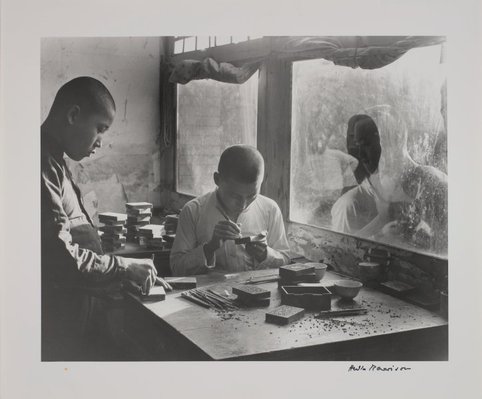-
Details
- Place where the work was made
-
China
- Dates
- 1940s
printed 1980s - Media category
- Photograph
- Materials used
- gelatin silver photograph
- Dimensions
- 23.5 x 29.3 cm
- Signature & date
Signed in ink l.r 'Hedda Morrison'
- Credit
- Gift of Dr Jim Masselos 1994
- Location
- Not on display
- Accession number
- 346.1994
- Copyright
- © Orphan work
- Artist information
-
Hedda Morrison
Works in the collection
- Share
-
-
About
Hedda Morrison’s photographic explorations of life both in China (1933–46) prior to the establishment of the People’s Republic, and later in Sarawak (1947–67) now a state of Malaysia, resulted in the creation of a vast personal archive (30 000 negatives) of great historic, social and cultural significance.
Produced while living in Peking, ‘Carving lacquer’ is one of a large number of photographs documenting Chinese workshop activities and the making of local craft objects. Taken from a frontal angle, and utilising available light from the window, this posed study of two artisans working, their faces averted with a figure peering in on the scene from outside, was a strategy that Morrison utilised to achieve a greater sense of naturalism. Influenced by the practices of prominent modernists, such as Albert Renger-Patzsch and August Sander, her profile of the handicraft, enclosed by the camera frame and rendered with clarity, directs attention to the specifics of the cinnabar lacquer carving process: the materials, tools, artists and the studio environment. In this sense, her photographic style, while characterised as picturesque, simultaneously privileges an identifiable representation of the subject and in so doing demonstrates a commitment to realism. It is through this attention to detail, process and people, combined with an interest in documentation of the ‘exotic’, that the intrinsic beauty of the unfamiliar and the everyday are revealed.
Conscious of the ever-changing ways of the world, Morrison, in her words, ‘tried to record faithfully in photographs whatever was typical of people, and which might not be there to photograph at all for very much longer’.1
1. Morrison H 1962, 'Life in a longhouse', Borneo Literature Bureau, Kuching p 5
© Art Gallery of New South Wales Photography Collection Handbook, 2007
-
Places
Where the work was made
China
-
Bibliography
Referenced in 1 publication
-
Martyn Jolly, Photography: Art Gallery of New South Wales Collection, 'International photo-documentary', pg.151-167, Sydney, 2007, 164 (illus.).
-

